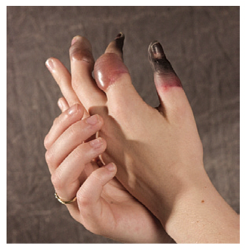HOW DOES ONE PREVENT SERIOUS TISSUE INJURY WITH INJECTABLE PROMETHAZINE?
Promethazine (Phenergan) is a commonly used medication that possesses antihistamine, sedative, anti-motion sickness, and antiemetic effects. It is available in many different dosage forms including tablets, oral solution/syrup, suppository, and an injectable solution.
 Injectable promethazine is a known vesicant that is highly caustic to the intima of blood vessels and surrounding tissue. Promethazine injection can cause serious damage to tissues especially if inadvertent intra-arterial or subcutaneous administration occurs, or if it extravasates. Adverse event reports include burning, pain, erythema, swelling, sensory loss, palsies, paralysis, severe spasm of distal vessels, thrombophlebitis, venous thrombosis, phlebitis, abscess, tissue necrosis, and gangrene. In some cases, surgical intervention, including, skin graft, and/or amputation have been required.
Injectable promethazine is a known vesicant that is highly caustic to the intima of blood vessels and surrounding tissue. Promethazine injection can cause serious damage to tissues especially if inadvertent intra-arterial or subcutaneous administration occurs, or if it extravasates. Adverse event reports include burning, pain, erythema, swelling, sensory loss, palsies, paralysis, severe spasm of distal vessels, thrombophlebitis, venous thrombosis, phlebitis, abscess, tissue necrosis, and gangrene. In some cases, surgical intervention, including, skin graft, and/or amputation have been required.
The Institute for Safe Medication Practices (ISMP) brought attention to the risk of serious tissue damage with parenteral promethazine in August 2006 and highlighted several safe practice recommendations to prevent or minimize risk for tissue damage. The Food and Drug Administration (FDA) also required a boxed warning for promethazine hydrochloride injection highlighting the risk of severe tissue injury, including gangrene, in September 2009. ISMP now recommends the elimination of injectable promethazine from hospital formularies.
HOW TO PREVENT SERIOUS TISSUE INJURY
The preferred route of parenteral administration of promethazine is by deep intramuscular injection and is contraindicated to be given via intra-arterial and subcutaneous routes. If the IV route of administration is necessary, the manufacturer recommends the following to reduce the associated risks:
1. Give the drug in concentrations no greater than 25 mg/mL
2. Administer the drug at a rate no greater than 25 mg/minute
3. Inject the drug through the tubing of an infusion set that is running and known to be functioning satisfactorily
4. Stop the injection immediately if the patient reports burning to evaluate possible arterial placement or perivascular extravasation
Along with the manufacturer recommendations, ISMP recommends considering the following strategies to prevent or minimize tissue damage when giving IV promethazine:
1. Limit the concentration by stocking only the 25 mg/mL concentration (do not stock the 50 mg/mL concentration)
2. Limit the dose by starting with the 6.25 mg or 12.5 mg dose of promethazine
3. Dilute the drug by requiring further dilution of the 25 mg/mL strength to reduce vesicant effects and enable slow administration
4. Use large patent veins by giving injectable promethazine only through a large-bore vein (preferably via a central venous access site, but absolutely no hand or wrist veins) and check patency of the access site before administration
5. Inject into the furthest port from the patient’s vein
6. Administer slowly over 10 to 15 minutes
7. Educate patients by informing patients of the risks and to alert someone immediately if burning or pain occurs during or after the injection
8. Create alerts to appear on the medication administration record (MAR) and best practice advisories (BPAs) to view each time an order is placed, or a nurse is preparing to administer IV promethazine reminding them of the hazards and safety best practices
9. Use safer alternatives that can be used for the same conditions IV promethazine treats, such as ondansetron (Zofran), prochlorperazine (Compazine), etc.
10. Remove injectable promethazine from formulary or ban IV administration as serious tissue injury can continue to occur despite implementation of the previous safety measures
MANAGEMENT OF PROMETHAZINE EXTRAVASATION
There is no proven successful management of unintentional intra-arterial injection or perivascular extravasation after it occurs. Sympathetic block, systemic heparin and vasodilators have been employed with variable success. The limb should be elevated to reduce compartment pressures and encourage a reduction in edema.
References:
1. Action needed to prevent serious tissue injury with IV promethazine. Institute For Safe Medication Practices. https://www.ismp.org/resources/action-needed-prevent-serious-tissue-injury-iv-promethazine. Published August 10, 2006. Accessed May 25, 2022.
2. Promethazine conundrum: IV can hurt more than IM injection! Institute For Safe Medication Practices. https://www.ismp.org/resources/promethazine-conundrum-iv-can-hurt-more-im-injection. Published November 2, 2006. Accessed May 25, 2022.
3. Grissinger M. Preventing serious tissue injury with intravenous promethazine (Phenergan). P&T. 2009;34(4):175-176.
4. Institute for Safe Medication Practices (ISMP). ISMP Targeted Medication Safety Best Practices for Hospitals; 2022. https://www.ismp.org/guidelines/best-practices-hospitals.
5. Promethazine. Lexi-Drugs. Lexicomp. Wolters Kluwer Clinical Drug Information, Inc. Updated May 27th, 2022. Accessed May 27th, 2022. https://online.lexi.com
6. Promethazine hydrochloride injection [prescribing information]. Hikma Pharmaceuticals; April 2022.
7. Reynolds PM, MacLaren R, Mueller SW, Fish DN, Kiser TH. Management of extravasation injuries: a focused evaluation of noncytotoxic medications. Pharmacotherapy. 2014;34(6):617-32. doi: 10.1002/phar.1396.
Question prepared by Mary Katherine Cella Shultz, PharmD, PGY1 Pharmacy Resident, VUMC
Preceptor: Bob Lobo, PharmD, BCPS, FCCP
Director, Medication Use / Education / Research
Department of Pharmacy, VUMC
Comment: Some things are just good to know. This is a drug that has a huge potential adverse effect if administered intravenously (reminds me of phenytoin). One wonders if IV administration of this drug is ever necessary (note number 9 above). If deciding it is necessary, know the risks.
I am interested in any questions you would like answered in the Question of the Week. Please email me with any suggestions at donna.seger@vumc.org.
If you are changing emails and would like to continue to receive the Question of the Week, send me your new email address and I will add it to the distribution list.
DONNA SEGER, MD
Professor Emeritus
Department of Medicine
VUMC
Tennessee Poison Center
24/7 toll-free Poison Help Medical Hotline
1-800-222-1222